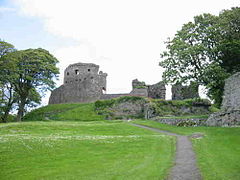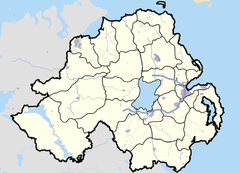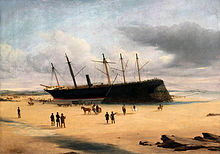- Dundrum, County Down
-
For other places with the same name, see Dundrum (disambiguation).
Coordinates: 54°15′N 5°51′W / 54.25°N 5.85°W
Dundrum Irish: Dún Droma 
Dundrum Castle
 Dundrum shown within Northern Ireland
Dundrum shown within Northern IrelandPopulation 1,065 (2001 Census) District Down County County Down Country Northern Ireland Sovereign state United Kingdom Post town NEWCASTLE Postcode district BT33 Dialling code 028 EU Parliament Northern Ireland UK Parliament South Down NI Assembly South Down List of places: UK • Northern Ireland • Down Dundrum (from Irish: Dún Droma, meaning "fort of the ridge")[1][2] is a village and townland in County Down, Northern Ireland. It is beside Dundrum Bay, about 4 miles outside Newcastle on the A2 road. The town is best known for its ruined Norman castle. It had a population of 1,065 people in the 2001 Census.
Contents
History
- In the 17th century Ulster ports began to rise in prominence. In 1625 William Pitt was appointed as Customer of the ports of Newcastle, Dundrum, Killough, Portaferry, Donaghadee, Bangor and Holywood.[3]
- Coal was a major import into Dundrum, where the East Downshire Steamship Company was based. Dundrum ceased to be a commercial port in 1984.
- The SS Great Britain, one of the first iron ships and designed by Isambard Kingdom Brunel, was on its way from Liverpool to New York in 1846, when it ran aground during bad weather in Dundrum Bay. The captain, James Hosken, miscalculated the steamer's speed, and with poor charts, mistook the St John's Point lighthouse for the Chicken Rock lighthouse. He tried to turn to starboard and North after passing the wrong lighthouse. It took a year to re-float the ship but it continued in use for many years before being installed as a visitor attraction in Bristol, where it can still be seen.
- Dundrum is considered the location where Briccriu held a great feast for Conchobar mac Nessa and the heroes of Ulaid.
Places of interest
- Medieval Dundrum Castle with its circular keep and massive walls is set high on a hill overlooking the sea. It was built shortly before 1210, on an earlier fortified earthwork, from which the place-name element 'dun' derives. The building was begun by John de Courcy, who led the 1177 Norman invasion of East Ulster. The castle was to guard the land routes from Drogheda via Greencastle to Downpatrick. It was visited by King John in 1210, who spent money for minor works to the castle and paid for a garrison there. Subsequently the castle was held by the Earls of Ulster and, from the middle of the 14th century, by the Magennises of Mourne. In 1517 it was captured by the Earl of Kildare and later by Lord Deputy Grey in 1538. The castle was surrendered to the Crown in 1601 by Phelim Magennis, granted to Edward Lord Cromwell and sold to the Blundell family. The Magennises took the castle briefly in 1641, but the Blundells returned after the war and built the house on the south edge of the castle.The British horror film Wilderness starring Sean Pertwee had scenes filmed at the Dundrum Castle.
- The Murlough Nature Reserve is situated between Dundrum and Newcastle. The rugged sand dunes and beach are National Trust property.
Transport
Dundrum railway station opened on 25 March 1869, but was finally closed on 16 January 1950.[4]
Sport
Dundrum Cricket Club plays in the NCU Senior League.
People
- Comedian and television presenter, Patrick Kielty, was born (in 1971) and raised in Dundrum.
Demographics
Dundrum is classified as a village by the NI Statistics and Research Agency (NISRA)[5] (ie with population between 1,000 and 2,250 people). On Census day (29 April 2001) there were 1,065 people living in Dundrum. Of these:
- 23.1% were aged under 16 and 18.1% were aged 60 and over
- 49.6% of the population were male and 50.4% were female
- 57.3% were from a Roman Catholic background and 39.0% were from a Protestant background
- 4.1% of people aged 16–74 were unemployed.
For more details see: NI Neighbourhood Information Service
References
- ^ Placenames NI
- ^ Placenames Database of Ireland
- ^ O'Sullivan, Aidan & Breen, Colin (2007). Maritime Ireland. An Archaeology of Coastal Communities. Stroud: Tempus. p. 211. ISBN 978-0-7524-2509-2.
- ^ "Dundrum station". Railscot - Irish Railways. http://www.railscot.co.uk/Ireland/Irish_railways.pdf. Retrieved 2007-09-05.
- ^ NISRA.gov.uk
External links
Categories:- Villages in County Down
- Townlands in County Down
Wikimedia Foundation. 2010.


